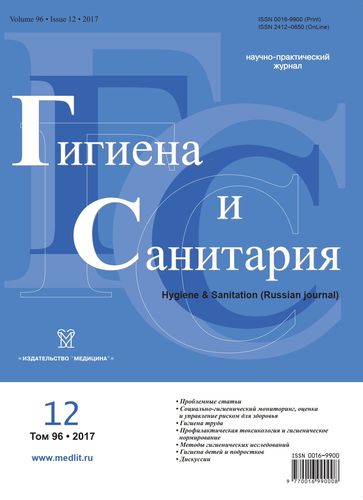Experimental studies of toxic effects’ of metallic nanoparticles at iron and nonferrous industries and risk assessment for workers` health
- Authors: Sutunkova M.P.1
-
Affiliations:
- The Medical Research Center for Prophylaxis and Health Protection in Industrial Workers of the Federal Service for Surveillance on Consumer Rights Protection and Human Wellbeing
- Issue: Vol 96, No 12 (2017)
- Pages: 1182-1187
- Section: PREVENTIVE TOXICOLOGY AND HYGIENIC STANDARTIZATION
- Published: 21.10.2020
- URL: https://archivog.com/0016-9900/article/view/640731
- DOI: https://doi.org/10.47470/0016-9900-2017-96-12-1182-1187
- ID: 640731
Cite item
Full Text
Abstract
The paper summarizes main results of our toxicological “in vivo“ experiments on white rats exposed to either a) a single intratracheal instillation of silver, gold, iron oxide, copper oxide, nickel oxide, manganese oxide, zinc oxide and lead oxide nanoparticles (NPs) in stable water suspensions without any chemical additives, b) repeated intraperitoneal injections the same NPs, c) low-level long-term inhalation exposure to the iron oxide nano-aerosol. We found these NPs to be much more noxious on both cellular and systemic levels as compared with their one micrometer or even submicron counterparts. The retention and distribution of metal and metal oxide NPs in the body are controlled by both physiological and physicochemical processes, depended on both cytotoxicity and solubility in biological milieus (inherent in different NPs to varying degrees). The relative contributions of these processes to the toxicokinetics are various for different NPs, and specifically for iron oxide particles of an average diameter not exceeding 20 nm, which were studied in the chronic inhalation experiment, the role of the dissolution predominates. Our data were first to testify to the high activity of the macrophagic and neutrophillic pulmonary phagocytosis of NPs deposited in airways. This fact suggests safe levels of exposure to airborne nanoparticles to be possible in principle but should be much lower if compared with established ones for respective micrometric industrial dust.
About the authors
Marina P. Sutunkova
The Medical Research Center for Prophylaxis and Health Protection in Industrial Workers of the Federal Service for Surveillance on Consumer Rights Protection and Human Wellbeing
Author for correspondence.
Email: marinasutunkova@yandex.ru
ORCID iD: 0000-0002-1743-7642
PhD, Head of the Laboratory of the Environment Toxicology of the Ekaterinburg Medical Research Center for Prophylaxis and Health Protection in Industrial Workers of the Federal Service for Surveillance on Consumer Rights Protection and Human Wellbeing, Ekaterinburg, 620014, Russian Federation.
e-mail: marinasutunkova@yandex.ru
Russian FederationReferences
- КKatsnel’son B.A., Minigalieva I.A., Privalova L.I., Sutunkova M.P., Gurvich V.B., Shur V.Ya., et al. Lower airways response in rats to a single or combined intratracheal instillation of manganese and nickel nanoparticles and its attenuation with a bio-protective pre-treatment. Toksikologicheskiy Vestnik. 2014; (6): 8-14. (in Russian)
- Katsnelson B.A., Degtyareva T.D., Minigalieva I.A., Privalova L.I., Kuzmin S.V., Yeremenko O.S., et al. Sub-chronic systemic toxicity and bio-accumulation of Fe3O4 nano- and microparticles following repeated intraperitoneal administration to rats. Int. J. Toxicol. 2011; 30(1): 60-7.
- Katsnelson B.A., Privalova L.I., Gurvich V.B., Makeyev O.H., Shur V.Y., Beikin J.B., et al. Comparative in vivo assessment of some adverse bio-effects of equidimensional gold and silver nanoparticles and the attenuation of nanosilver’s effects with a complex of innocuous bioprotectors. Int. J. Mol. Sci. 2013; 2(14): 2449-83.
- Katsnelson B.A., Privalova L.I., Kuzmin S.V., Degtyareva T.D., Sutunkova M.P., Yeremenko O.S., et al. Some peculiarities of pulmonary clearance mechanisms in rats after intratracheal instillation of magnetite (Fe3O4) suspensions with different particle sizes in the nanometer and micrometer ranges: Are we defenseless against nanoparticles? Int. J. Occup. Environ. Health. 2010; 4(16): 508-24.
- Katsnelson B.A., Privalova L.I., Sutunkova M.P., Khodos M.Y., Shur V.Y., Shishkin E.I., et al. Uptake of some metallic nanoparticles by, and their impact on pulmonary macrophages in vivo as viewed by optical, atomic force, and transmission electron microscopy. J. Nanomed. Nanotechnol. 2012; 3: 1-8.
- Privalova L.I., Katsnelson B.A., Loginova N.V., Gurvich V.B., Shur V.Y., Valamina I.E., et al. Subchronic Toxicity of Copper Oxide Nanoparticles and Its Attenuation with the Help of a Combination of Bioprotectors. Int. J. Mol. Sci. 2014; 15(7): 12379-406.
- Privalova L.I., Katsnelson B.A., Loginova N.V., Gurvich V.B., Shur V.B., Beikin Y.B., et al. Some Characteristics of Free Cell Population in the Airways of Rats after Intratracheal Instillation of Copper-Containing Nano-Scale Particles. Int. J. Mol. Sci. 2014; 15(11): 21538-53.
- Minigalieva I.A., Katsnelson B.A., Panov V.G., Privalova L.I., Varaksin A.N., Gurvich V.B., et al. In vivo toxicity of copper oxide, lead oxide and zinc oxide nanoparticles acting in different combinations and its attenuation with a complex of innocuous bio-protectors. Toxicology. 2017; 380: 72-93.
- Sutunkova M.P., Katsnelson B.A., Privalova L.I., Gurvich V.B., Konysheva L.K., Shur V.B., et al. On the contribution of the phagocytosis and the solubilization to the iron oxide nanoparticles retention in and elimination from lungs under long-term inhalation exposure. Toxicology. 2016; 363: 19-28.
- Sutunkova M.P., Solovyeva S.N., Katsnelson B.A., Gurvich V.B., Privalova L.I., Minigalieva I.A., et al. A paradoxical response of the rat organism to long-term inhalation of silica-containing submicron (predominantly nanoscale) particles of a collected industrial aerosol at realistic exposure levels. Toxicology. 2017; 384: 59-68.
- Donaldson K., Stone V., Tran C.K., Kreyling W., Borm P.J. Nanotoxicology (Editorial). Occup. Environ. Med. 2004; 61(9): 727-8.
- Oberdörster G., Oberdörster E., Oberdörster J. Nanotoxicology: an emerging discipline evolving from studied of ultrafine particles. Environ. Health Persp. 2005; 113(7): 823-39.
- Fadeel B. Clear and present danger? Engineered nanoparticles and the immune system. Swiss Med. Wkly. 2012; 142: w13609.
- Sager T.M., Porter D.W., Robinson V.A., Lindsley W.G., Schwegler-Berry V.A., Castranova V. Improved method to disperse nanoparticles in vitro and in vivo investigation of toxicity. Nanotoxicol. 2007; 1(2): 118-29.
- Privalova L.I., Katsnelson B.A., Osipenko A.B., Yushkov B.H., Babushkina L.G. Response of a phagocyte cell system to products of macrophage breakdown as a probable mechanism of alveolar phagocytosis adaptation to deposition of particles of different cytotoxicity. Environ. Health Perspect. 1980; 35: 205-18.
- Fröhlich E. Cellular targets and mechanisms in the cytotoxic action of non-biodegradable engineered nanoparticles. J. Curr. Drug Metab. 2013; 14(9): 976-88.
Supplementary files









